DeFi Lending and Borrowing
Instructors: Andreas Park


What's interesting about Defi Lending?

2021
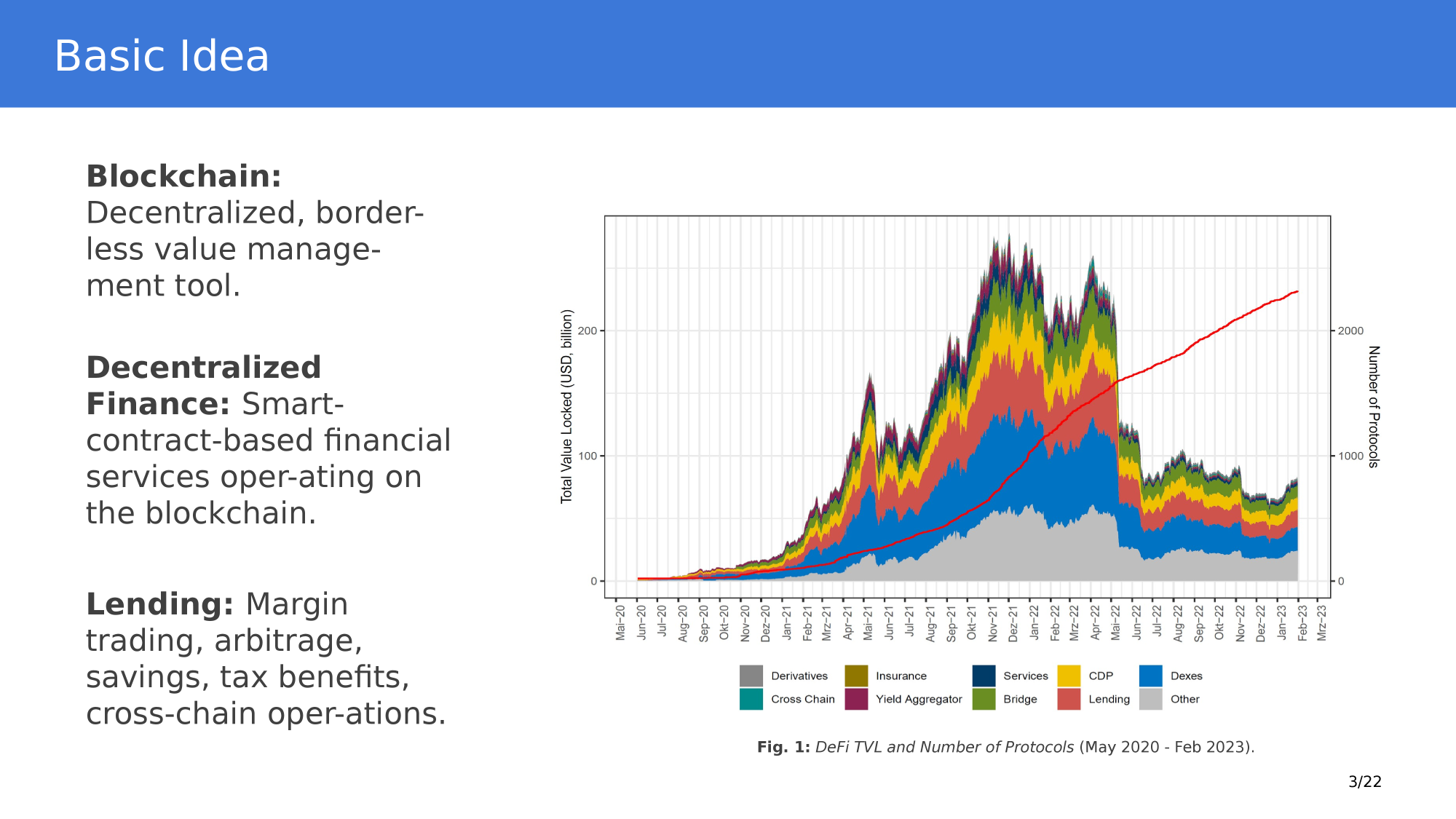

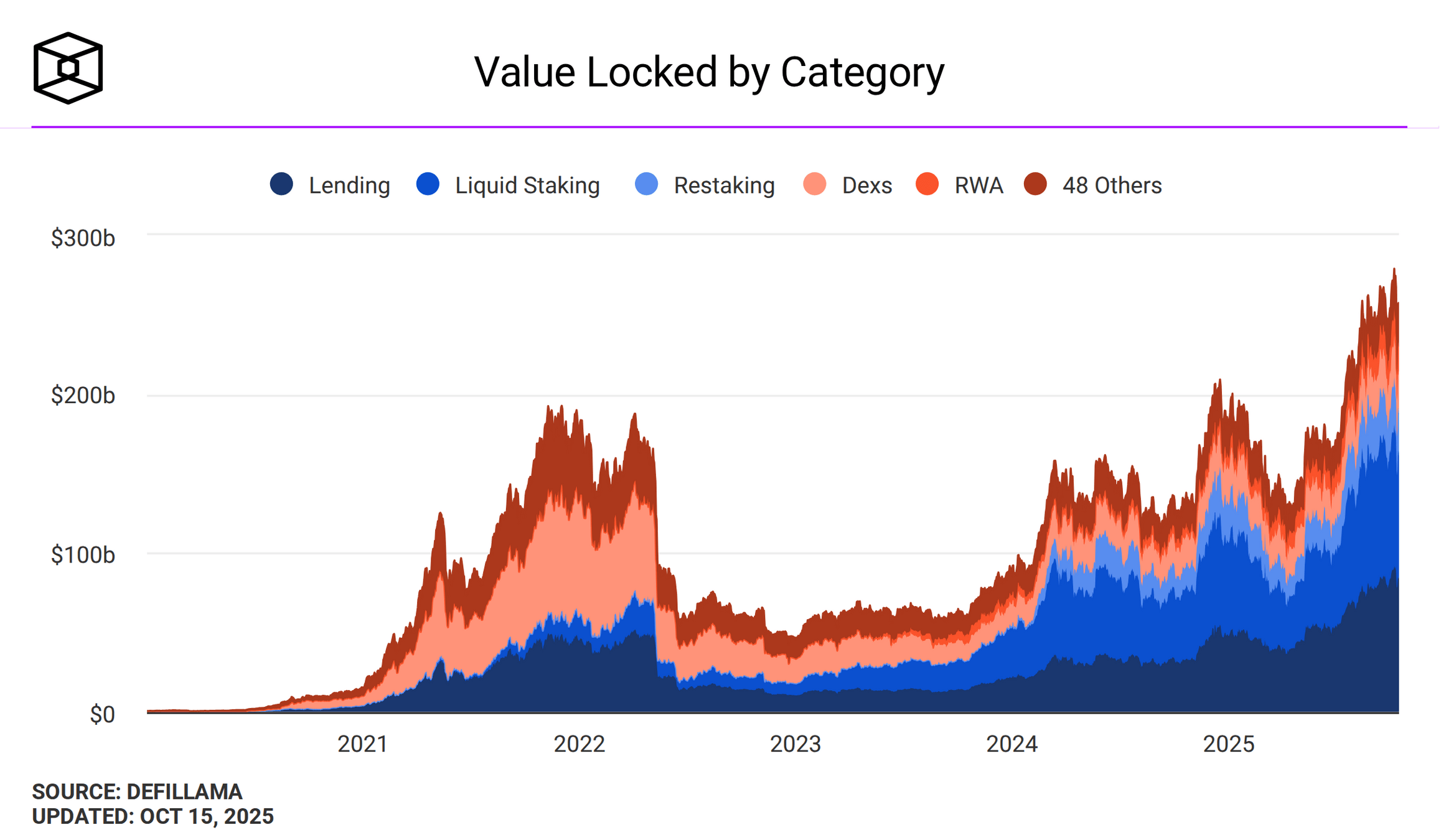


the empirical part will focus on this episode
What are the core functions that a DeFi Ecosystem must cover?
- creation of assets
- trading of assets
- borrowing and lending
- creation of derivative assets
What are the core functions that a DeFi Ecosystem must cover?
- creation of assets
- trading of assets
- borrowing and lending
- creation of derivative assets
Liquidity transformation
- convert an "illiquid" asset into cash temporarily
- = borrow against some form of collateral
Credit
- obtain cash temporarily for a fee
- = borrow against your good name
Comparative advantage
- borrow an asset
temporarily because you can use it better
MakerDAO/Sky
Maple Finance
AAVE/Compound/Morpho
MakerDAO
user perspective

4 ETH
(1 ETH = $375)
(Oct 15, 2020)
\(\approx\) $1,500













\(\vdots\)
1,500 DAI
(1 DAI = $1)
formally: this smart contract is a collateralized debt position (CDP)



Prerequistes
Key Components for Defi
borrowing/lending
on-chain ability to exchange arbitrary value


(last class)
Borrowing/Lending & Unit of Account creation

Idea:
- create fiat money on chain with borrowing
- mechanism
- a collateralized loan with ETH in escrow
- DAO-managed monetary policy (=creation or destruction of tokens)
Sidebar: what is a DAO?
- DAO=decentralized autonomous organization
- \(\to\) entity without management
- governance decided by token holders essentially by vote
- We'll devote a class to DAO governance
user perspective
fractional collateral \(\to\) collateralization factor \(=\) 150%
total collateral = $1,500
maximum loan = $1000
overcollateralization = $500
actual loan (example) = $500
buffer = $500
user perspective: what happens if the price of ETH rises?
ETH \(\nearrow\) $500
value of ETH collateral = $2,000
maximum loan = $2,000/150%=$1,333
total collateral = $2,000
maximum loan = $1,333
overcollateralization = $667
actual loan (example) = $500
buffer = $500
overcollateralization = $667
new loan capacity= $333
user perspective: what happens if the price of ETH falls?
ETH \(\searrow\) $187.5
value of ETH collateral = $750
maximum loan = $750/150%=$500
total collateral = $750
maximum loan = $500
overcollateralization = $250
actual loan (example) = $500
buffer = $0
for reference: former value of collateral
user perspective: what happens if the price falls & max loan is exceeded?
Maker DAO
ETH \(\searrow\) $150
value of ETH collateral = $600
maximum loan = $600/150%=$400
total collateral = $600
maximum loan = $400
required overcollateralization = $200
actual loan (example) = $500
buffer = -$100
for reference: former value of collateral
\(\Rightarrow\) triggering of liquidation auction by "keeper"
sell 3.33 ETH=$500=500 DAI
repay $500=500 DAI loan
retain incentive
return remainding ETH to vault owner
Maintaining the Peg: monetary policy
Maker DAO
- How works:
- 1 USDC=1.01 DAI
- use USDC to mint new DAI
- supply (DAI) \(\nearrow\)
- price (DAI) \(\searrow\)
- use USDC to mint new DAI
- 1 USDC=0.99 DAI
- Swap Dai for USDC (more below)
- demand (DAI) \(\nearrow\)
- price (DAI) \(\nearrow\)
- 1 USDC=1.01 DAI
\(\Rightarrow\) all relies on behavioral assumptions
\(\Rightarrow\) But: there are also real incentives & mechanisms
Maintaining the Peg: monetary policy
Maker DAO
- stability fee
- DAI savings rate (DSR)
- debt ceiling
borrowers of DAI need to pay interest \(\to\) stability fee
- if too much minting (=too much DAI) then
- \(\to\) interest \(\nearrow\) \(\to\) cost of DAI \(\nearrow\)
- \(\to\) minting \(\searrow\) \(\to\) supply DAI \(\searrow\)
DSR paid on "locked" DAI
- DAI deposited to specific contract (demand \(\nearrow\))
- funded by stability fees
- \(\to\) SF>DSR
total amount of debt (or DAI) outstanding is limited
Sidebar: how is this decided?
\(\to\) special "governance" token MKR

Value locked Oct 27, 2021
Maker DAO

Source: daistats.com (Oct 27, 2021)

Source: daistats.com (Oct 26, 2022)

The March 12, 2020 "BlAck Thursday" Drama
Maker DAO
- some crypto prices dropped more than 50%
- cascading liquidations in leveraging platforms
- network congestion: some liquidations done at near-zero prices
- collateral shortfall in DAI
- MakerDAO sold new DAO tokens to collect collateral
- odd: DAI became riskier but high demand for DAI to trigger liquidations!
PEG stability module (PSM)
Maker DAO
The Problem:
- in extreme bull/bear runs, the peg may no longer work
- example: March 2020
- ETH dropped significantly and suddenly
- a rush occurred to (a) get out of ETH into save assets and (b) to collect DAI to get keeper fee
- upward pressure on price of DAI
The Solution:
- Peg stability module
- swap a given collateral type directly for DAI at a fixed rate (no minting/borrowing)
- like regular vault type with a zero stability fee and a liquidation ratio of 100%
- accessed through a user-facing smart contract containing the relevant swap functions (no ownership, just straight swap)
Note: In May 2021, ETH prices dropped again by >30% but no drama in DAI
MakerDao's Peg Stability Module as an AMM



categories and assessment for defi
assessment of makerdao
Interest rates influenced by the FED, access to loan products controlled by regulation and institutional policies
MakerDAO platform is openly controlled by the MKR holders.
Difficulty of obtaining loans for large majority of population
Open ability to take out DAI liquidity against an overcollateralized position in any supported ERC20 token. Access to a competitive USD denominated return in DSR.
Costs of time and money to acquire a loan
Instant liquidity with minimal transaction costs.
Can't seamlessly use the same USD across many platforms
Issuance of DAI, a permissionless USD-tracking stablecoin backed by cryptocurrency. DAI can be used in any smart contract or DeFi application.
interoperability
inefficiency
centralized control
limited access
opacity
Unclear collateralization of lending institutions.
Transparent collateralization ratios of vaults visible to entire ecosystem
legacy finance
MakerDAO

The frontier: DAI loans for real-world assets
Maker DAO
Pool-based lending principles
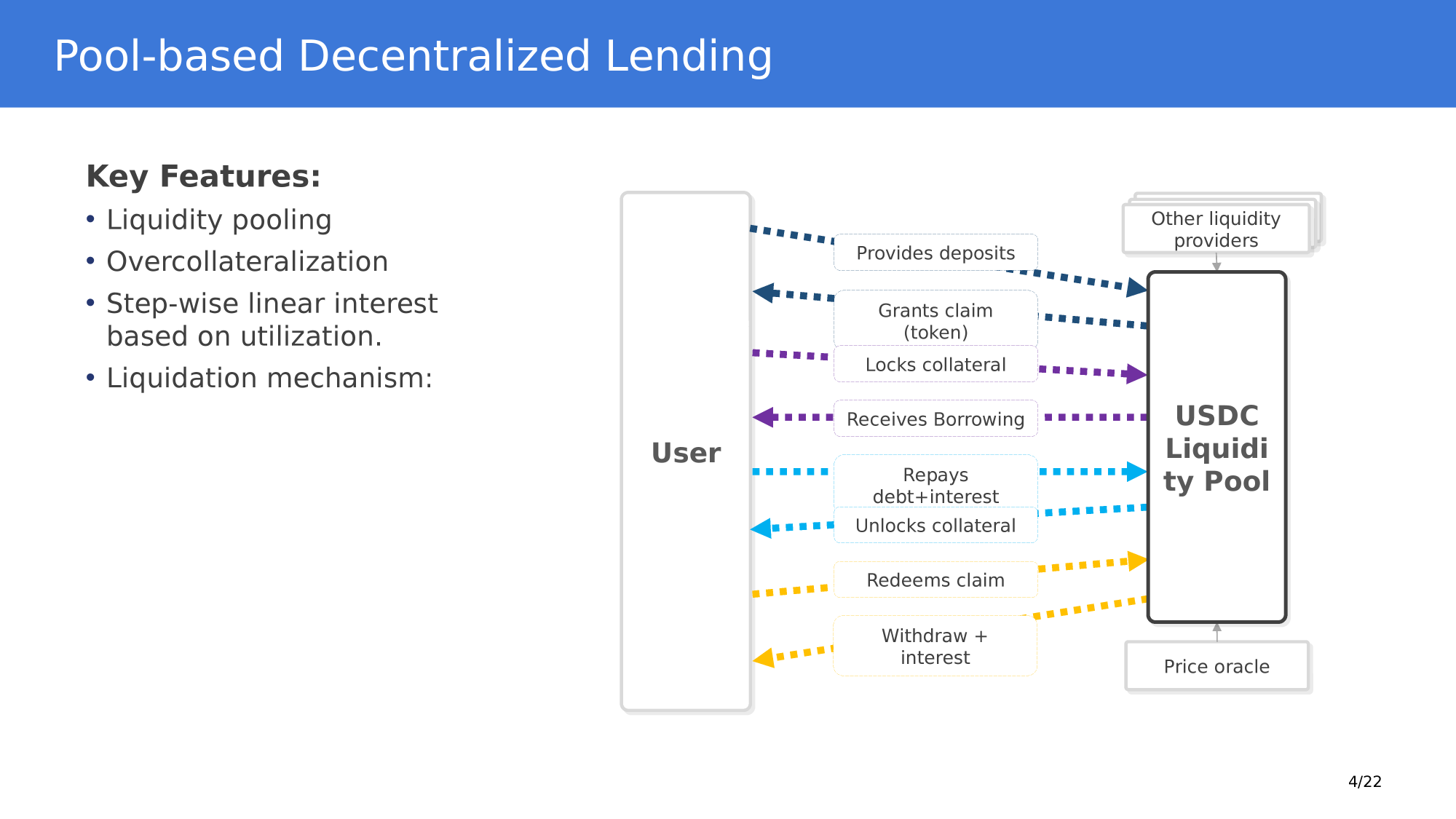

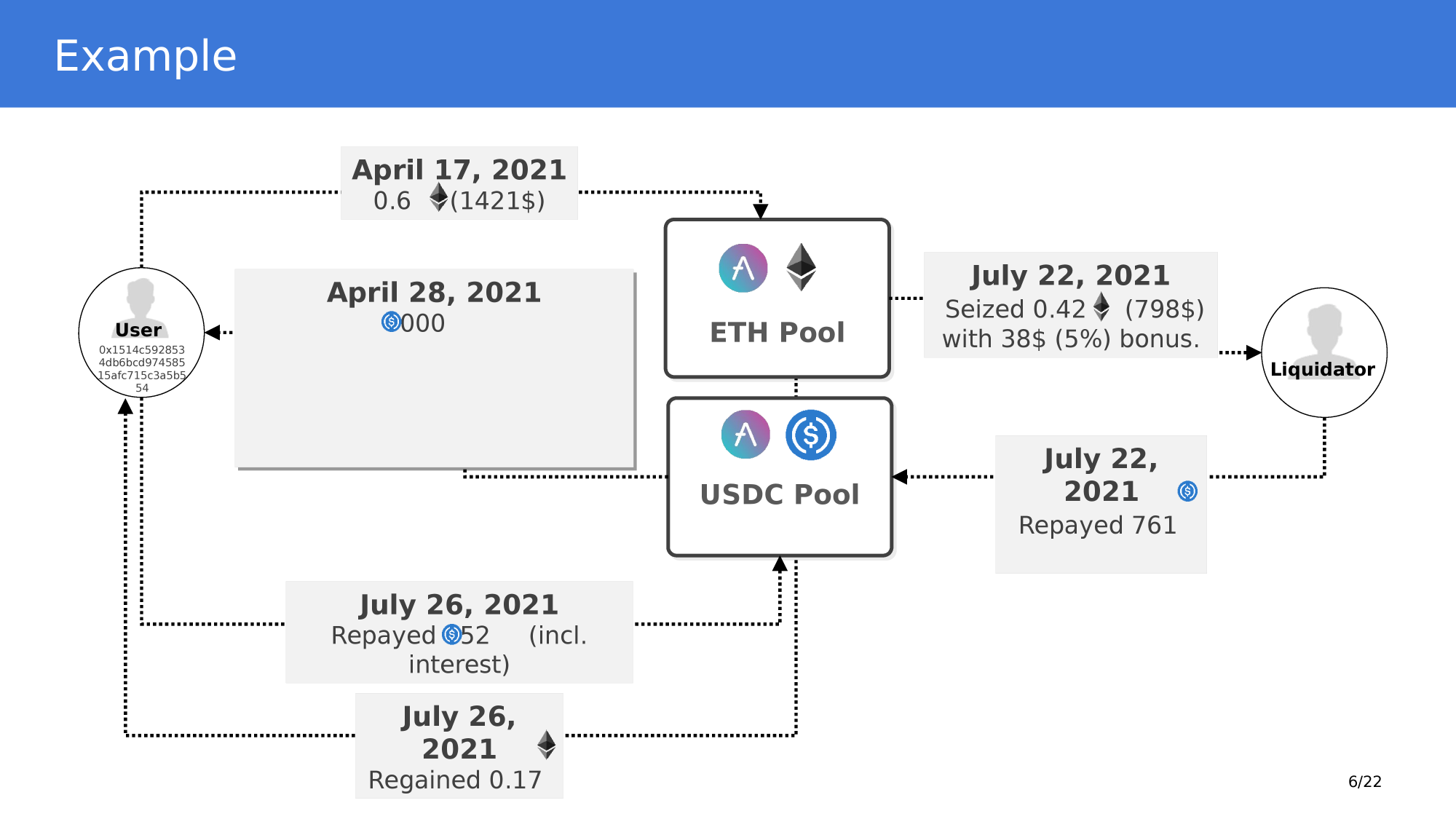
collateral
compound Finance
- Collateral ratio \(\in[0,90]\)
- =0 \(\to\) not usable
- =90 \(\to\) stablecoin
- post 100 DAI
- factor 90
- \(\to\) for each $1 borrow, deposit $100/90=$1.11
- can borrow up to $90
- post 1 ETH=$300
- factor 60
- \(\to\) for each $1 borrowed, deposit $100/60=$1.67
- can borrow up to $180
Example 1
Example 2
Example 3
- post 1 ETH=$300 and 100 DAI \(\to\) $400
- factor 60 and 90
- \(\to\) for each $1 borrowed, deposit
$100/(.75\(\cdot\)60+.25\(\cdot\) 90)=$1.48 - can borrow up to $270

borrowing and lending rates compounded per block
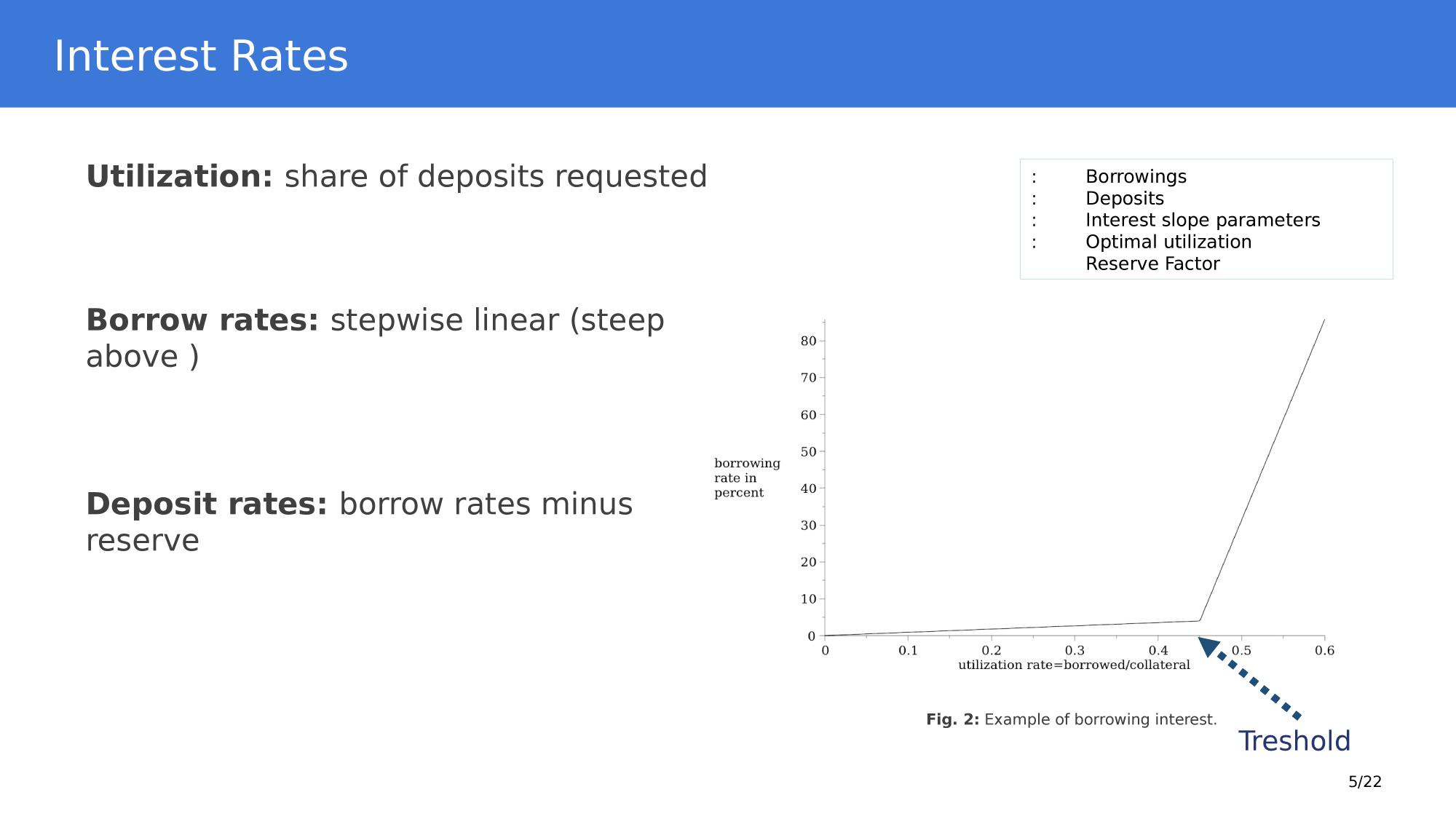

Pool-based Defi Lending: Theory
Riviera, Saleh, Vanderweyer (2025)
Pool-based Decentralized Lending: economic function = the price
- price function is ad hoc
- but can it work well = achieve the most efficient outcome?
- How do they measure "good"?
- loosely:
- higher volume
- = better capital use
- = most efficient
- best = like competitive market
- loosely:
Riviera, Saleh, Vanderweyer: Results
Without uncertainty over how many people may enter the market, welfare can be made arbitrarily close to competitive equilibrium welfare.
For any admissible borrower interest rate function, there exists a unique stationary equilibrium in utilization
With uncertainty users worry about excessive rates (borrowers) or low income (lenders) => they "internalize and use the lending protocol less"
Economic Intuition
-
no uncertainty: Users’ informed actions reveal the market state via utilization; DLP can set rates close to competitive levels.
-
With uncertainty: Random shocks to credit market conditions create rate volatility; risk-averse users reduce borrowing/lending ex-ante to avoid bad outcomes, lowering utilization.
Riviera, Saleh, Vanderweyer: Translating Econ-Speak to Practice: what do we learn?
Practical Implications
-
Design: Interest rate functions should heavily penalize utilization near 100% and set low rates when far below it.
-
Limits: No interest rate function can fully remove inefficiency if users face uncertainty.
-
Oracle problem: Overrated in this context — user uncertainty is the real constraint.
Token Accounting:
tracking ownership
Compound
AAVE
Token Accounting: TWO Types
- track ownership of pool holdings with receipt tokens
- continuous updating of wallet balances
How does compound finance work?
Lending

Fundamentally, what does a bank do?
- size intermediation
- term intermediation
- risk intermediation
And how is this done?
- pooling deposits
- issuing loans based on deposits
- loan rates based on collateral or credit rating
on blockchain
- short-term loans
- pseudo-anonymous
how are the rates determined? - a function
compound Finance
100%
fraction of supplied that's been borrowed
base rate
borrow rate
token accounting
Compound
- deposit: add \(q_0\) units of \(A\)-tokens into a pool that contains \(Q_0\)
- assume: \(Q^c_0\) units of the \(cA\)-receipt tokens outstanding already
- User receives \(q^c\) receipt \[ \frac{q^c}{Q_0^c+q^c}=\frac{q_0}{Q_0+q_0}.\]
- Exchange rate: \(z_t=\frac{Q_t}{Q_t^c}\) of \(A\) to \(cA\)-tokens.
- Interest accrues so that pool contains \(Q_T>Q_t\) of the \(A\) token after time \(T\)
- When withdrawing, users sends \(q^c\) tokens to the contract
- Receives \(q_T>q_0\) of the \(A\)-token at exchange rate \(z_t>z_0\) where \[q_{T}=Q^c \times z_{T}\]
compound Finance
- Compound escrows tokens
- must account for % ownership
- \(\to\) tokenized user share
- \(\to\) use the c-token
- cDAI
- cETH
- minted/burned based on funds added/removed from underlying
- seamless movement of these shares (reduced transactions costs!)
- ability to use the ctokens in other protocols

Tracking ownership - How do you reclaim a deposit?
Tracking ownership - Example
compound Finance
In Compound
translated
new deposit
1,000 DAI
100 cDAI
500 DAI
add 50 new cDAI
Tracking ownership - Example
compound Finance
In Compound
translated
new deposit
1,000 DAI
150 cDAI
500 DAI
1 year later: 10% interest on compound
150 DAI
(same cDAI, ownership shares don't change, just each cDAI is worth more)
(accrues per block per deposit)
AAVE
Differences to Compound
Aave
- Aave is the now the largest lending protocol
- has many features that are similar to Compound
- offers more assets
- offers flash loans (rate ~7bs)
- token accounting done by continuous updating of token balance
token accounting
Aave
- User makes a deposit continuously receives "a-tokens"
- Supply:
- \(Q_0\) units of an asset \(A\) token to the Aave pool obtains
- \(Q_0\) units of \(aA\)-tokens
- balance updates continuously (\to\) claim on more \(aA\) tokens
- To withdraw after \(T\) interest periods: sends her \(Q_T\) \(aA\)-tokens to the contract, where
\[Q_T= Q_0\prod_{t=1}^{T}{(1+r_t)}\] - \(t\) measured in blocks
- \(r_t=\) interest allocated per block \(t\)
Morpho
Liquidity Mining
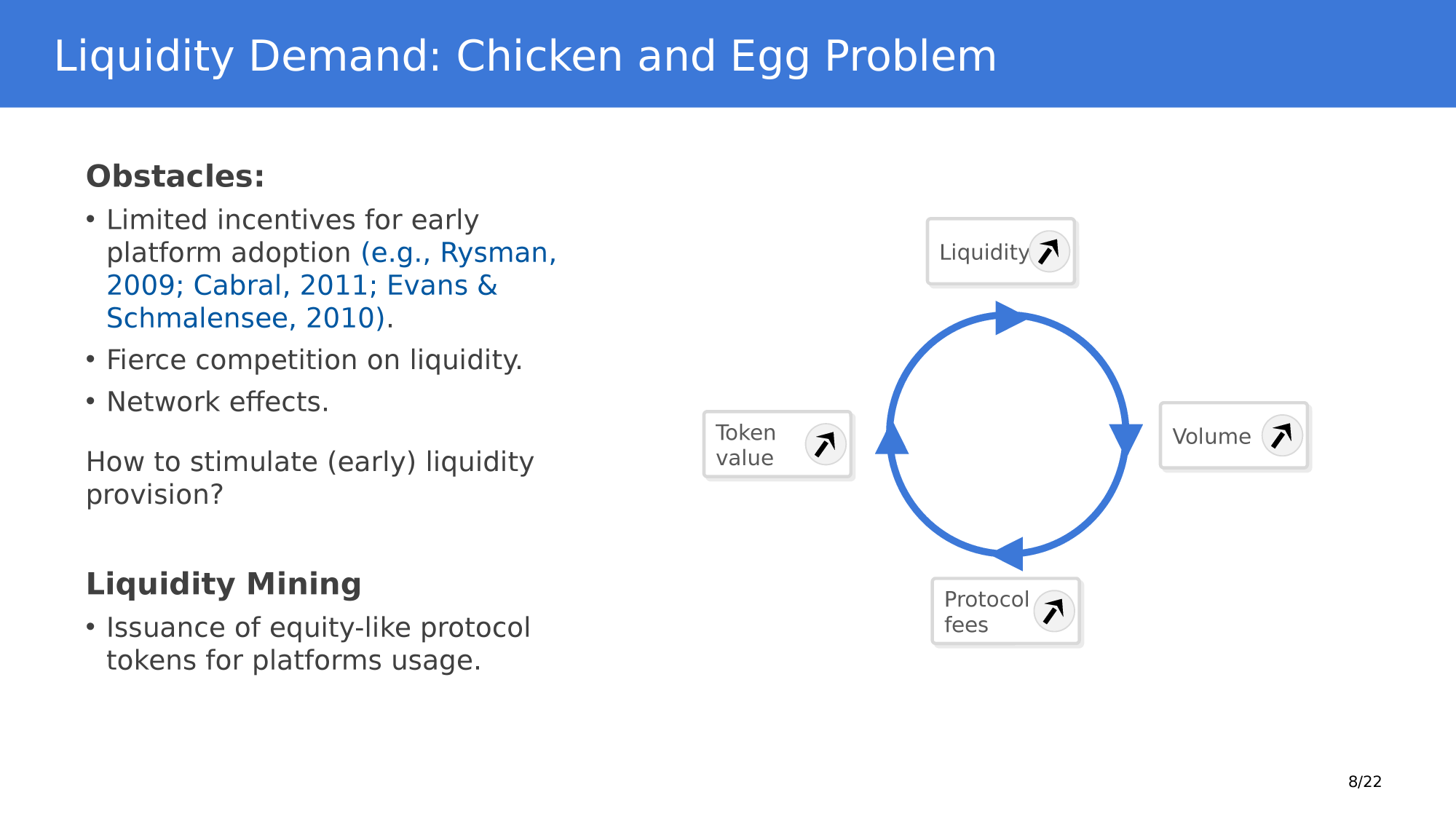
Park & Stinner (2025): Solving the Chicken and Egg Problem: Liquidity and Activity Incentives
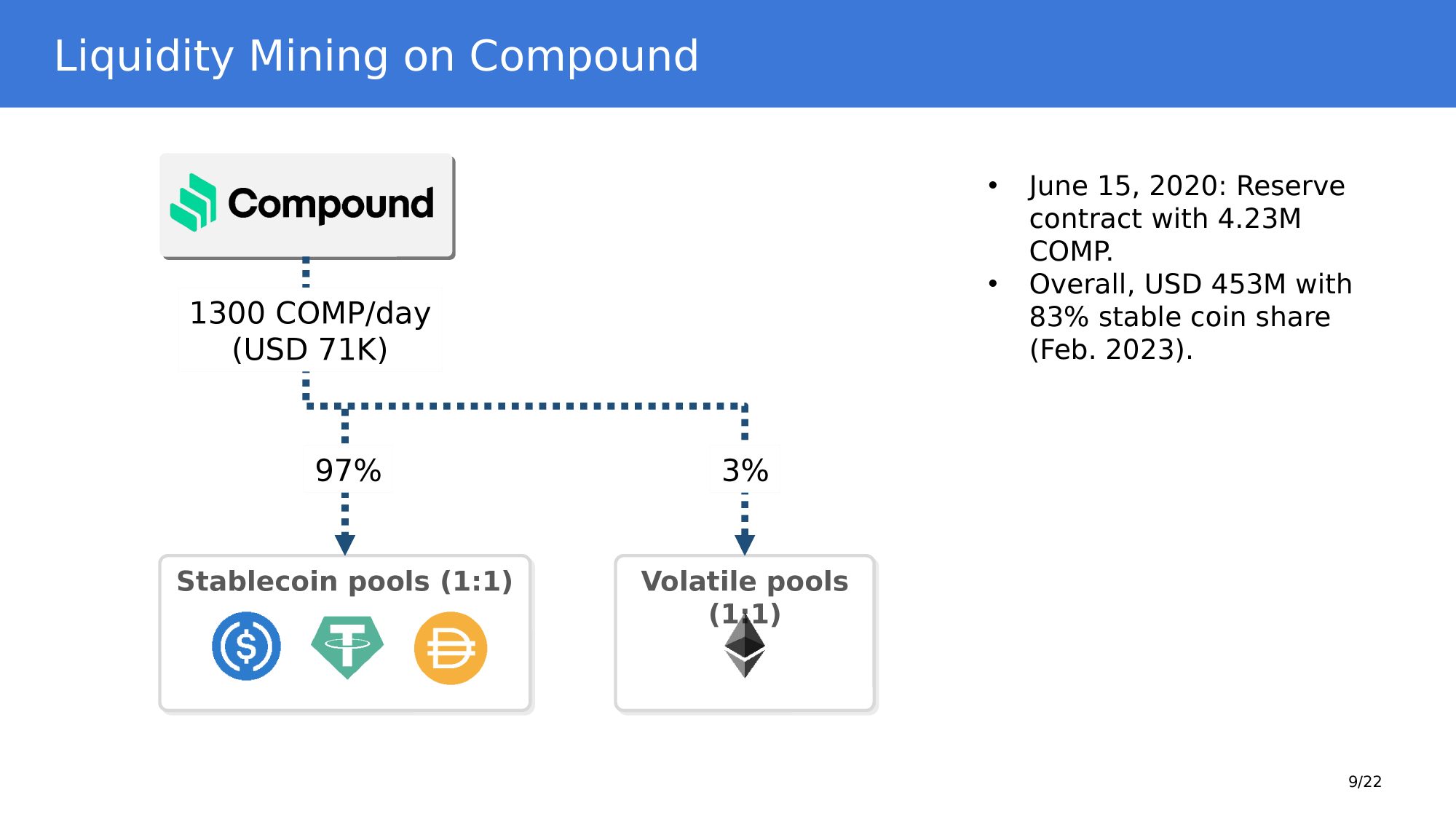
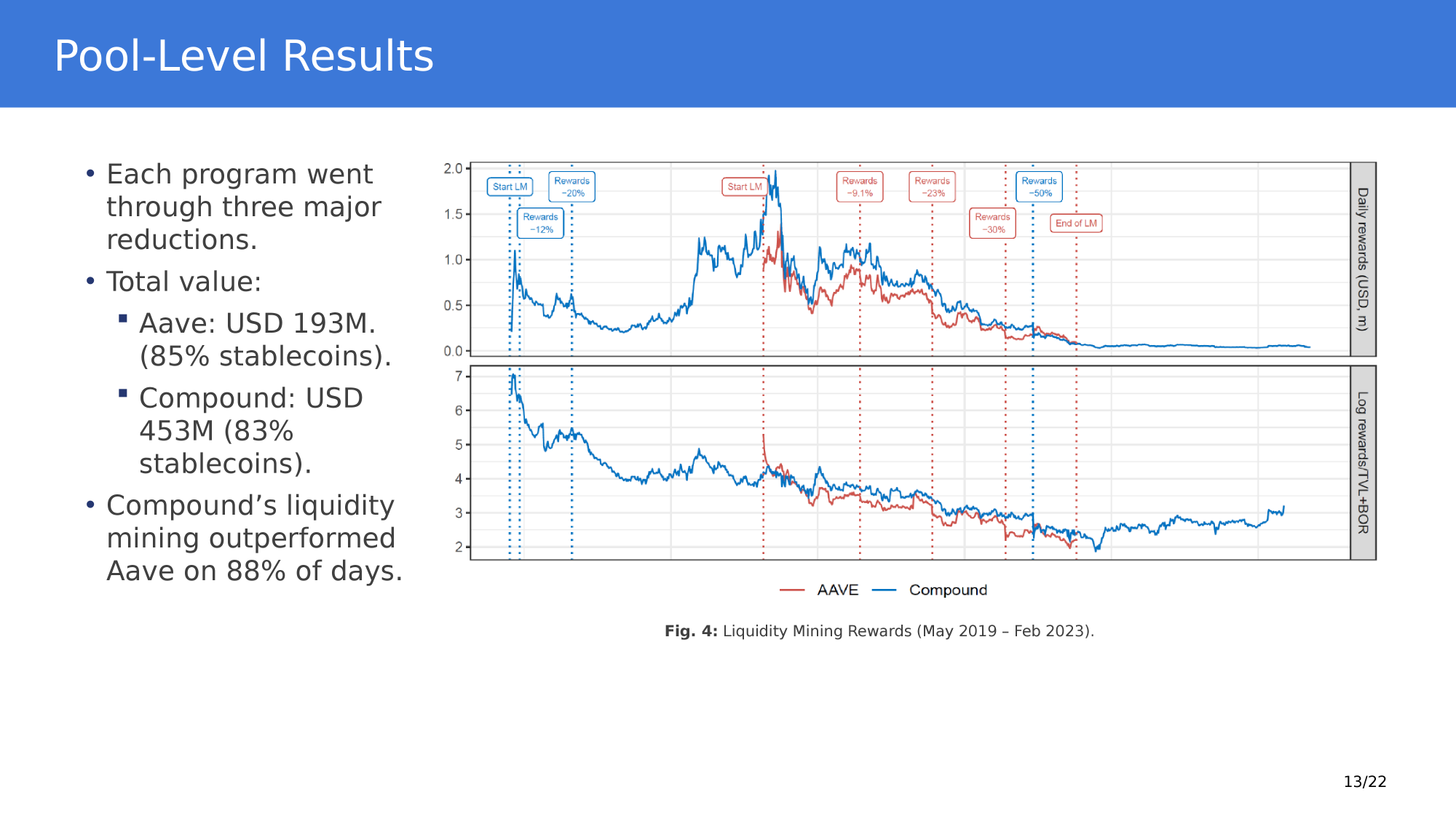
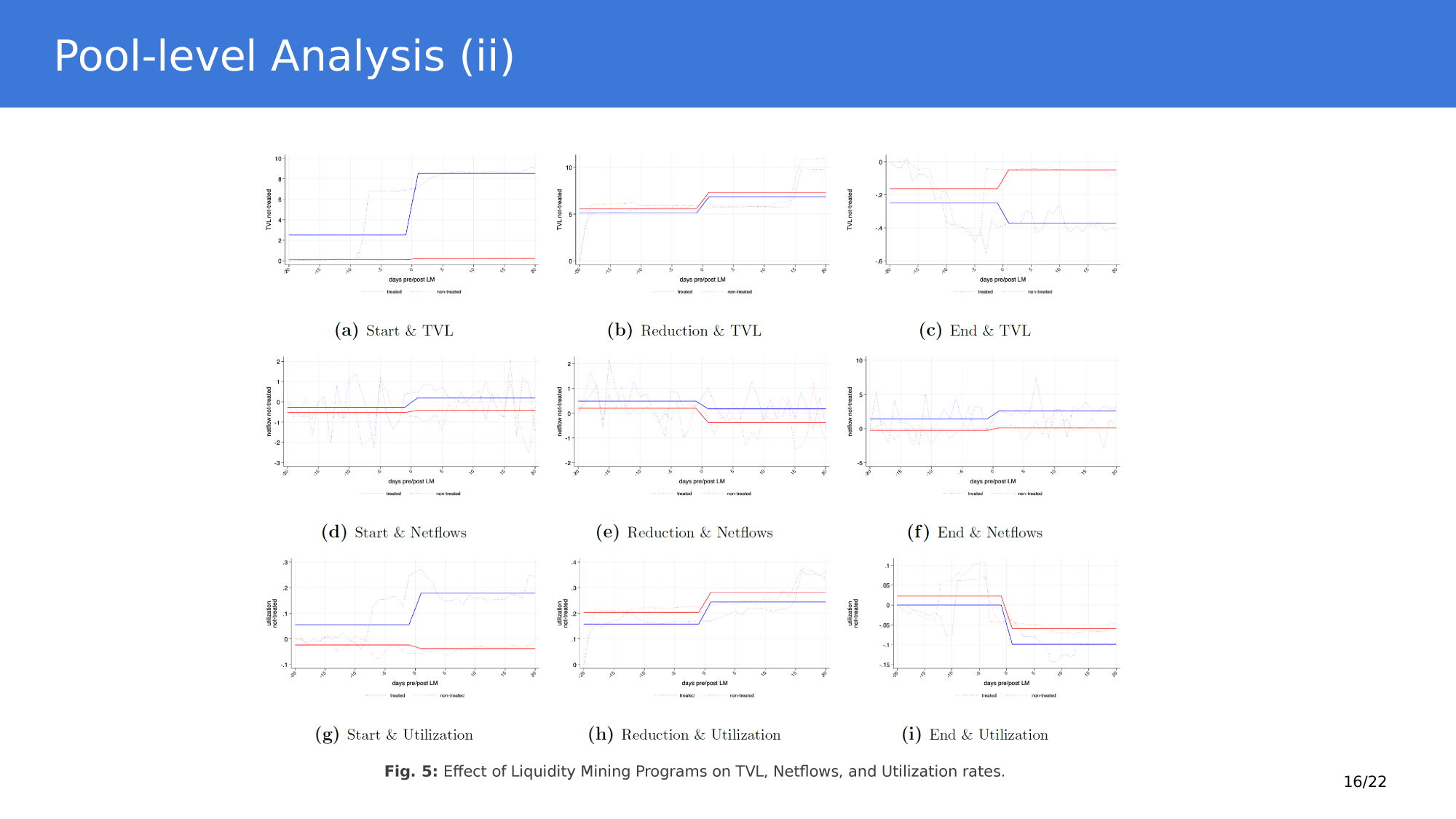
Yield Aggregators
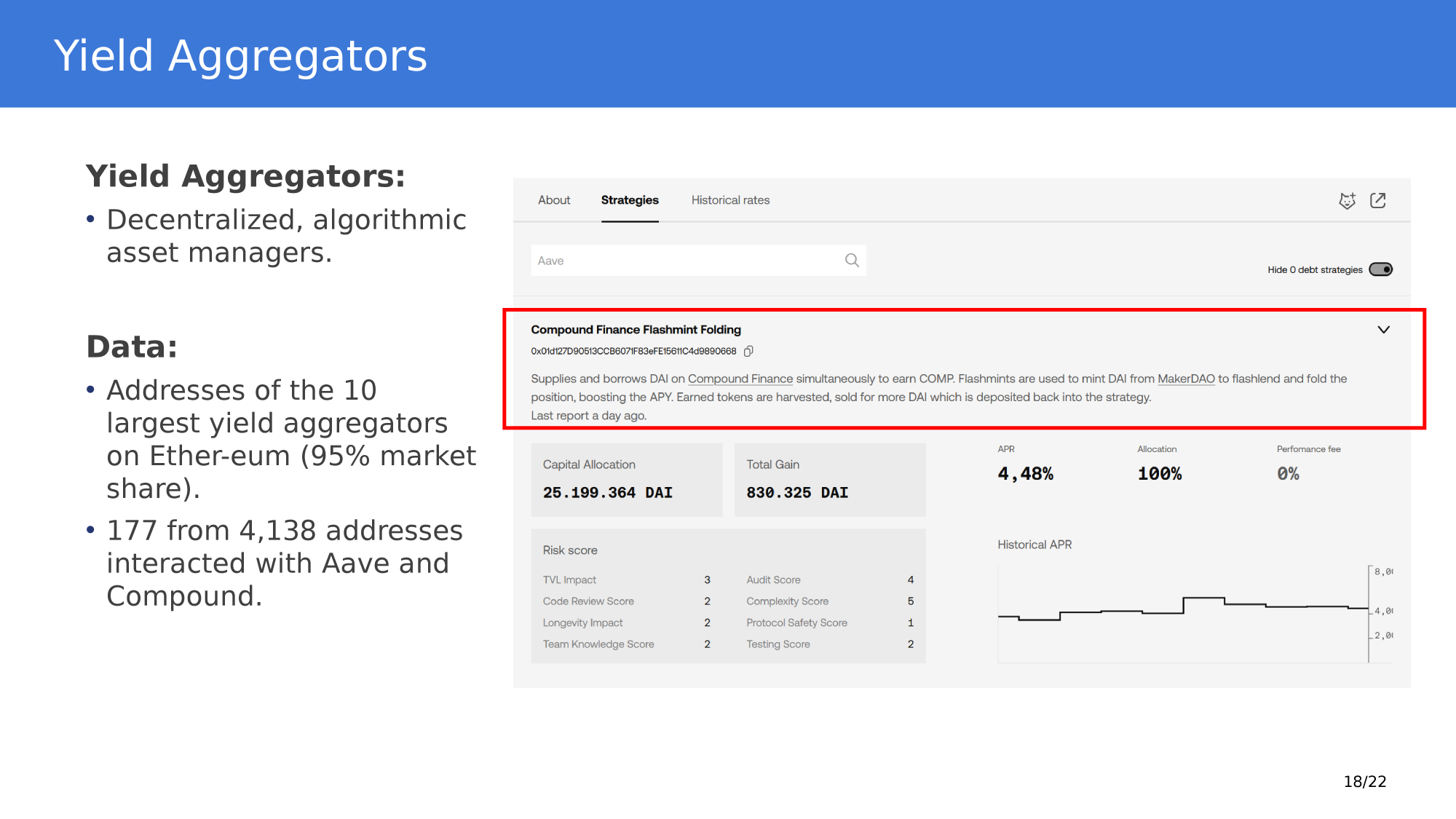
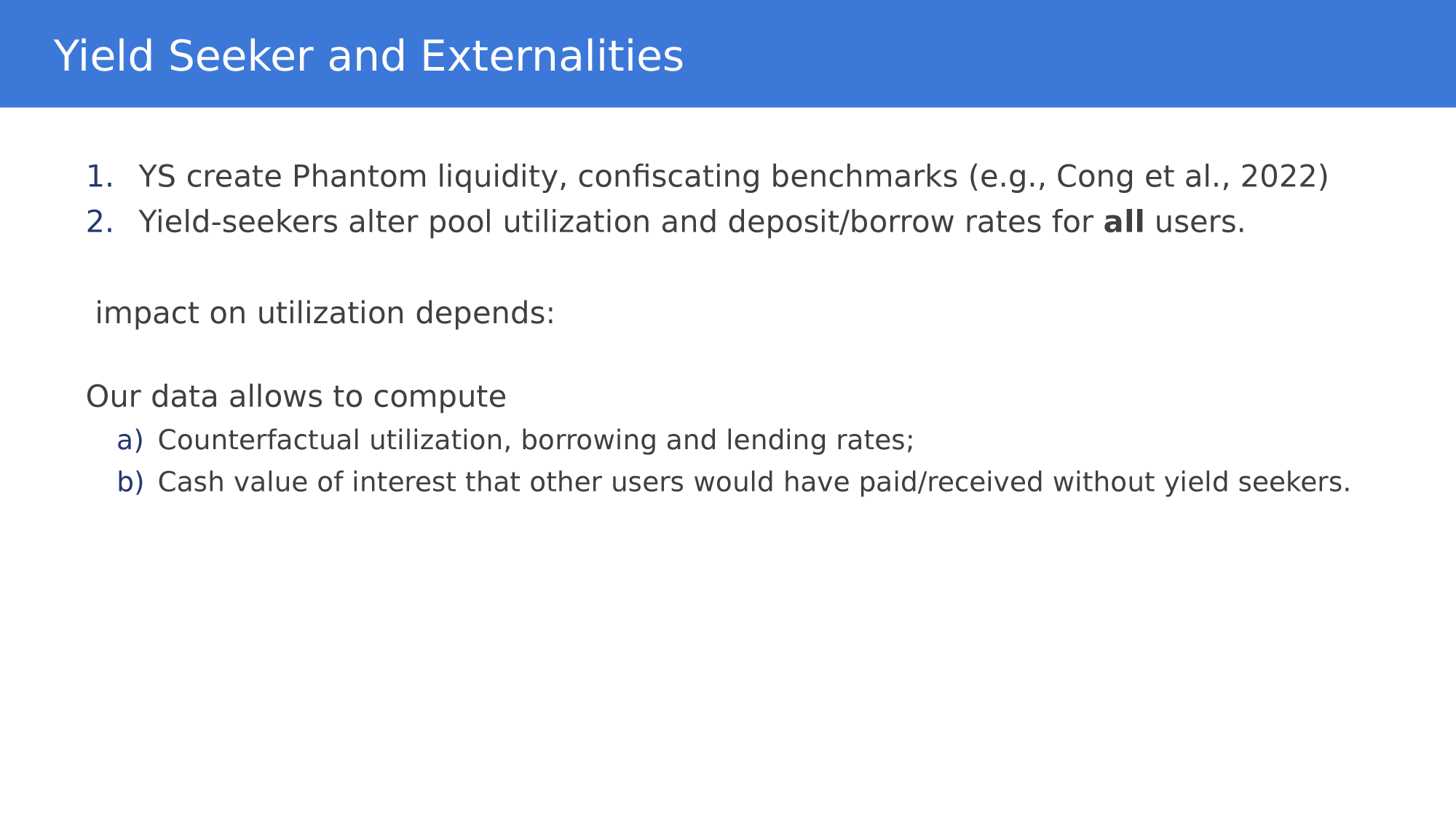

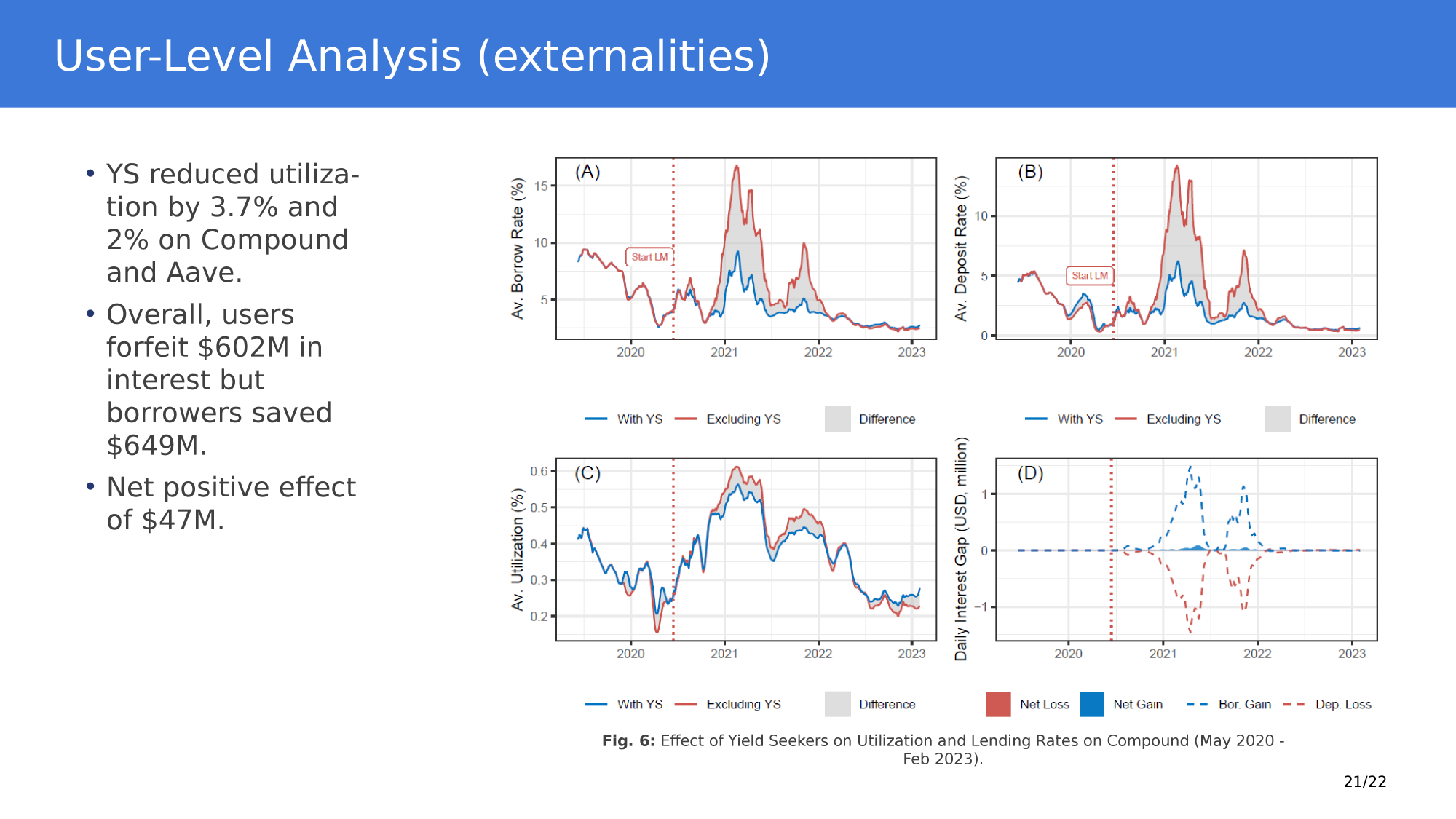
Flash Loans

common theme in DeFi: jumping between dApps
-
Assume
- 1 ETH = 200 DAI
- supplied 100 ETH in Compound
- borrowed 10,000 DAI to lever up and purchase an additional 50 ETH
- \(\to\) also supplied to Compound
-
Borrow interest rate in DAI
- Compound: 15%
- Aave: 5%.
- Can you refinance your borrowing?
dapp-linking
Defi is like real "high" finance

Source: Harvey, Ramachandran, and Santoro (2020)
Dapp composability & Flash loans


1. flash-borrow DAI

5. repay DAI


3. receive ETH

4. convert ETH to DAI

2. liquidate ETH loan with DAI

Loan liquidation opportunity
- Use collateral repeatedly to lever up:
- Deposit ETH as collateral.
- Borrow USDC against it up to some LTV.
- Swap borrowed USDC to ETH.
- Deposit new ETH as collateral.
- Repeat 2–4 until near the LTV limit.
- End state: larger ETH exposure, USDC debt in the lending protocol.
Using Flash Loans for Leverage

- Has 10 ETH
- wants 22 ETH exposure
Naive Solution: Spiral Borrowing

- deposit ETH
- borrow DAI










- sell DAI
- buy ETH
- deposit ETH
- borrow DAI
- sell DAI
- buy ETH
- deposit ETH
- borrow DAI
- Price: 1 ETH = 2,000 USDC
- Collateral factor (max LTV) on ETH: 70%
- Start: 10 ETH → value = 20,000 USDC
Loop 0
- Deposit 10 ETH (20,000 USDC value)
- Borrow 14,000 USDC (70% of 20,000)
- Swap 14,000 USDC → 7 ETH
- Deposit 7 ETH → total collateral = 17 ETH (34,000 USDC)
Loop 1
- Max debt now = 0.7 × 34,000 = 23,800 USDC
- Current debt = 14,000 → can borrow 9,800 more
- Borrow 9,800 USDC, swap → 4.9 ETH, deposit
- Total collateral = 21.9 ETH (43,800 USDC), total debt = 23,800 USDC
Toy example
Result
- Start: 10 ETH, no debt
- End: ~21.9 ETH collateral, 23,800 USDC debt
- Achieved via multiple transactions and intermediate risk states
-
Flash loan: borrow with no collateral, do operations, then repay principal + fee within the same transaction; otherwise everything reverts.
-
Use it to “jump” directly to a target leveraged state:
- Flash-borrow USDC.
- Swap USDC → ETH.
- Deposit all ETH as collateral.
- Borrow USDC from the lending protocol.
- Use that USDC to repay the flash loan.
-
End state after one transaction:
- Large ETH collateral in the protocol
- USDC debt in the protocol
- No flash-loan debt
now with a flash loan

- Has 10 ETH
- wants 22 ETH exposure
Clever (gas-efficient) solution: flash loan

- flash-borrow DAI





- deposit ETH
- borrow DAI


- sell DAI
- buy ETH
- repay DAI flashloan
- Same parameters as before:
- Price: 1 ETH = 2,000 USDC
- Collateral factor: 70%
- Target: ~21.9 ETH collateral, 23,800 USDC debt
Inside a single transaction
- Flash-borrow 23,800 USDC.
- Swap 23,800 USDC → 11.9 ETH.
- Add your 10 ETH → 21.9 ETH total; deposit all as collateral.
- Collateral value = 21.9 × 2,000 = 43,800 USDC
- Max debt at 70% LTV = 30,660 USDC (we only need 23,800 + fee)
- Borrow 23,800 USDC from Aave.
- Repay the flash loan (23,800 + fee).
Toy example with flash loan
Result
- Collateral: 21.9 ETH in Aave
- Debt: ~23,800 USDC to Aave
- Flash loan fully repaid
- Same economic position as the spiral, created atomically in one transaction
Commercial Paper/T-Bill like securities
YIELD Protocol
- basic idea: zero-coupon loans
- You have:
- target asset
- collateral
- y-token trading at discount price
- examples: yDAI
- expires in 1 year
- price: $.92
- backed by ETH
- buying = you earn 8/92 cents=8.7% RoR

YIELD example
1 ETH = 150 DAI
collateralization ratio 125%
seller
buyer
Assumptions

supplies 1 ETH collateral today

mints (=borrows) 100 yDAI to be repaid in 1 year
y

receives 92 DAI today

pays 92 DAI today

y
receives 100 yDAI
repays loan with 100 DAI
deposits yDAI and receives 100 DAI

YIELD example: scenarios

seller
buyer
Scenario 1: ETH \(\ge\)125 DAI
deposits 100 yDAI
withdraws 100 DAI
receives balance of 1 ETH - 100 DAI
What does the seller own (ignore keeper fee)?
- 92 Dai (the loan)
- 0.2 ETH x price(ETH)=25 DAI (assume price=125)

seller
buyer
Scenario 2: ETH falls to <125 DAI
keeper
closes undercollateralized position \(\to\) sells 0.8 ETH for 100 DAI
receives 100 DAI early
receives balance
of 0.2 ETH
categories of finance
What do banks/financial institutions do?
disclaimer: an incomplete list
Bitcoin,
stablecoins, etc.

"higher layer"







lending
payments processing
financial
advice
trading
services
funding
services
prop trading to manage risks

too early, but projects are underway



as it turns out, these items are often directly related
what could defi do?
Five key problems in finance
Defi vs Legacy finance
interoperability
inefficiency
centralized control
limited access
opacity
interchange (=VISA) fees, settlement times, microtransactions, physical infrastructure
between-institution or transfers, reconciliation process, international remittances, various securities custody and trading systems
information for users, health of deposit taker, what-happens-behind-the-scenes, counterparty risk
local monopolies/switching costs, central banking, deposit concentration, control vs. competition
1.7B unbanked in the world, 24M in the US, many services or products not available based on location etc, lack of SME support, inability to collateralize

Source: Wendy Rotenberg's Payments lecture
payments pieces
simplified view

CDS
ACSS
LVTS
Cheques
Debit at POS
e-transfer
Credit Card/
open loop
ATMs
Wire
Interac
Credit
Card
deposit based retail
Interac standard
credit card network
SWIFT
CSN










Settlement
Clearing process
Underlying network
Type of payment
Financial market infrastructure purpose
Securities Trading
why blockchain?
a common resource








e-transfer
Wire
deposit based retail
CDS
Securities Trading
derivatives
swaps
property registry
interoperability
inefficiency
centralized control
limited access
opacity
siloed legacy system
is interoperable by design
reduces frictions and separates service from "commodity"
decentralized control and common operation
fewer barriers\(\to\) broad access
is/can be highly transparent
common infrastructure system
categories and assessment for defi
Our focus
interoperability
inefficiency
centralized control
limited access
opacity
- What do the projects do?
- How do these projects improve on legacy limitations?
payments
lending
trading
services
funding
services
prop trading
manage risks
@financeUTM
andreas.park@rotman.utoronto.ca

slides.com/ap248
sites.google.com/site/parkandreas/
youtube.com/user/andreaspark2812/